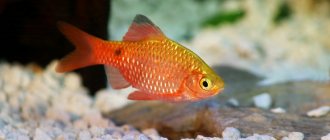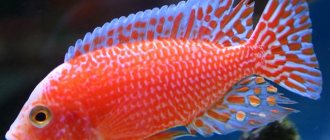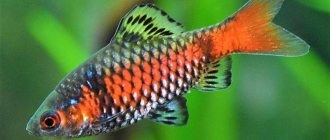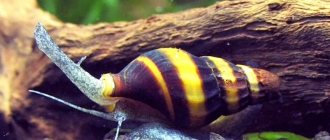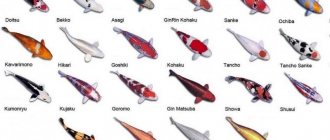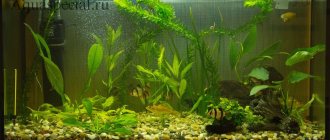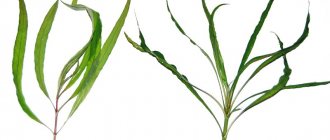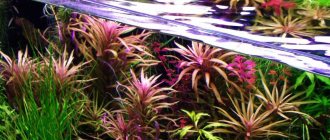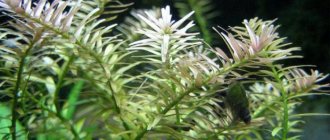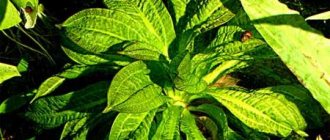Home › Aquarium plants › Catalog of aquarium plants ›
Your rating will be the first!
Pogostemon stellatus is a long-stemmed plant native to Southeast Asia and Australia. If there are several of its varieties, known in the aquarium hobby, differing in the width and size of the leaves. The narrow-leaved variety first appeared in the hobby about 17 to 19 years ago, when the plant was sold under the erroneous name Eusteralis Stellata. Plants imported from New Guinea are distinguished by a variety of leaf shapes. Broad-leaved forms are found with leaf widths reaching 15 cm!
Growing and care
Pogostemon octopus is quite picky about its conditions. For this reason, it is not suitable for beginners.
One of the conditions for good acclimatization of pogostemon is planting the plant in an “old” aquarium, in which a stable ecosystem has already formed.
Immediately after starting aquariums, a very unstable water condition is usually observed, which will have a detrimental effect on Pogostemon octopus.
Depending on the conditions of detention, the width and color of the leaf blades of Pogostemon octopus change.
Immediately after planting, the plant takes a long time to take root. On average, this process takes about a month, during which the pogostemon may not grow and at the same time lose almost all its leaves. After acclimatization, it is recommended to periodically trim the bushes.
This will keep the plant looking beautiful. Plus, after removing the upper part of the stem, it begins to bush, which gives greater splendor to the pogostemon. The cut parts can be used to produce new bushes.
Water parameters for ideal maintenance
To ensure the healthy state of Pogostemon Octopus, it will be necessary to maintain a stable state of water in accordance with the following indicators:
- temperature range - 22-28;
- hardness - 6-12;
- acid-base balance - 6-7.5.
An indicator of unfavorable conditions is pale leaves of pogostemon.
- Purity of water is very important to the plant. It is necessary to change a quarter of the fluid volume every week. Timely replacement of the filter and regular cleaning of the aquarium are also required.
- Otherwise, the leaf plates will begin to become covered with plaque, which impedes gas exchange processes. This will lead to poor growth of pogostemon. Additionally, care should be taken to ensure an uninterrupted supply of carbon dioxide.
Lighting requirements
Like many tropical plants native to Southeast Asia, pogostemon requires bright light.
It is advisable to choose lamps with a power of 0.5-1 W/l. Fluorescent lamps are best suited as a light source.
The plant should be supplied with light for 10-12 hours a day.
With a lack of lighting, the leaves of Pogostemon octopus will become pale and stretched, causing the plant to lose its decorative appearance.
When planting a plant, you need to position it so that the shoots do not shade each other, and also so that neighboring plants do not create shade.
Demanding requirements for soil and nutrient substrate
Pogostemon octopus has a powerful root system that requires a soil depth of at least 5-6 centimeters. The plant prefers silted substrate, which is formed mainly in “old” aquariums. It takes some of the nutrients from the silt, so it is permissible to use pebbles or sand as the main soil, under which a nutrient substrate can be placed.
As such a “fat” layer you can use:
- Tropica Substrate. Nutrient substrate based on peat and clay. Its main feature is that it practically does not change the acidity and hardness of the water in the aquarium. Slowly releases nutrients, providing plant nutrition for a long time.
- Dennerle NutriBasis. A substrate with a high content of chelated iron, clay minerals and peat will provide the pogostemon with a nutrient medium for a long time. According to the manufacturer, it differs in that when there is an excess of nutrients, it does not release them, but absorbs them.
Requirement for fertilizers
Pogostemon octopus receives the bulk of its nutrients through its roots. Therefore, it is best to use tablet fertilizers for additional feeding of the plant, or when the nutrient soil begins to deplete and will require immediate replacement.
Pogostemon octopus mainly needs microelements, especially iron. You can supply the plant with the necessary substances using the following fertilizers:
- API Root tabs. Tablet fertilizer with a high content of iron and potassium. Promotes the growth of aquarium plants. It is recommended to use every month.
- Tetra Crypto. Nutrition in tablet form, rich in microelements. Does not contain phosphates and nitrates, which are often present in the aquarium in sufficient quantities in an established ecosystem.
Aquadesign (aquascape)
Pogostemon stellatus can be used as an aquascape centerpiece in a large aquarium. Stunning color and large leaves create a beautiful contrast with other species.
The plant is recommended for aquariums from 130 liters; variants with wide leaves are best planted in very large aquariums, from 200 liters or more. Cultivars with needle-shaped leaves can be placed in the back of medium-sized aquariums, or in the middle line in larger aquariums.
Pogostemon stellatus is usually planted in 3-5 stems at a certain distance from each other - if planted too close, then over time the lower leaves will receive less light and begin to fall off.
Reproduction
Pogostemon octopus reproduces vegetatively.
In an aquarium environment, it is recommended to carry out the procedure as follows:
- cut off the upper part of the stem or side shoot at least 10 centimeters long;
- dig a small hole in the ground, at the bottom of which you can immediately put tableted fertilizer to maintain the root system;
- place the cut stem in the hole and sprinkle it with soil on top without compacting it.
Immediate family
The closest relatives of Octopus are the following plants:
- Pogostemon erectus. The most unpretentious of all pogostemons. It differs from octopus in having more compact leaves and shortened internodes.
- Pogostemon stellata (Pogostemon stellatus). Outwardly, it resembles Pogostemon erectus, but the lower part of its leaf blades has a purple tint.
- Pogostemon helfera. A plant with basal rosettes instead of a stem and decorative corrugated leaves.
- Pogostemon australis. It is distinguished by the strength of the stem and the pinkish tint of young shoots, which become grassy green with age.
Return to content
Variations and forms of the plant
Pogostemon octopus does not have its own artificially bred variations or natural forms found in nature. However, other types of pogostemons have found application in aquarium keeping:
- Erectus. The leaves are collected in whorls of 8 pieces. The length of the leaf plate reaches 4 cm, width up to 1 cm. A lush, dense bush can be obtained in 1-3 months if favorable conditions exist. Requires constant thinning.
- Helfer's Pogostemon. Its leaves also gather in whorls. The bush reaches 10 cm in height and 5 cm in width. It is mainly green in color. Pogostemon Helfera Red is distinguished by red leaves, which is reflected in the name of the subspecies.
- Stelatus. It is also star-shaped, has a high growth rate and can only be used in large aquariums due to the large length of the plant. The leaf plates are collected in whorls of 8 pieces, reaching 8-11 mm in length and up to 5 mm in width.
- Kimberly. The height of the bush of this pogostemon can grow up to 25-40 cm. It is distinguished by the presence of notches along the edges of the leaf plate.
Description
Pogostemon is an aquarium plant that grows naturally in Southeast Asia. It appeared on store shelves relatively recently - about 10 years ago. They are used to decorate the background of the underwater landscape.
The plant has erect stems with thin leaves. Their width is about 6 mm and their length is about 9 cm.
Did you know? If you place this type of pogostemon next to an air spray, the current will set its long leaves in motion, and they will begin to move, visually resembling the tentacles of an octopus. It was this moment that became decisive when choosing the name, since “octopus” is translated from Latin as “octopus”.
Its height is approximately 0.6 m, so most often the back wall of the aquarium is chosen for planting pogostemon. It is painted green. Due to the narrowness of the leaves and stems, octopus does not create a shadow.
Check out the list of the best aquarium plants, especially Java moss, Cryptocoryne, Diatoms, Hemianthus.
It is worth noting that herbivorous fish love to feast on it.
Interesting Facts
Eusteralis terry can be considered a marker of whether the water contains the necessary microelements, primarily iron. If the leaves turn pale, then you need to add microelements to the water and within a couple of days the plant will be transformed. The leaves will again acquire their unique color when the bright green is shaded with purple-crimson. All the unique beauty of eusteralis can only be appreciated when it reaches the top of the water. Pogostemon stellata is a large plant, so it will look great in the background of an aquarium. There is no need to frequently cut off the tips of the side shoots, otherwise the leaves will be crushed due to excessive tillering.
Here is such a capricious, but at the same time incomparably beautiful plant - Pogostemon stellata.
Fertilizing
Fertilizers must be applied directly to the soil at the root of the algae. This is explained by the fact that the plant receives most of its nutrients through the root. With a sufficient amount of nutrients, the bush forms a large root system; in an empty substrate, pogostemon forms only a few weak roots.
Don't forget to fertilize
Changes in color may indicate that the algae needs feeding. In order for the leaves to be constantly green, it is necessary to periodically apply preparations that contain a large amount of potassium.
Fertilizers must be applied as carefully as possible so as not to damage the root system. Fertilizing preparations can be purchased at any pet store. The optimal frequency of fertilizing should be twice every 7-9 days.
https://youtube.com/watch?v=Gf9dWZqkSrc
Brief conclusions
As you can see, the presence of a starfish in an aquarium imposes a number of restrictions on the selection of fish and requires careful monitoring of the composition of the water, lighting and feeding. However, these limitations are fully compensated by the beauty of this elegant and unusual plant. In any case, Pogostemon helfera remains a popular plant in aquadesign, capable of refreshing and decorating an aquarium of any size.
Lesson on how to properly plant pogostemon in an aquarium (video in English, but everything is intuitive):

